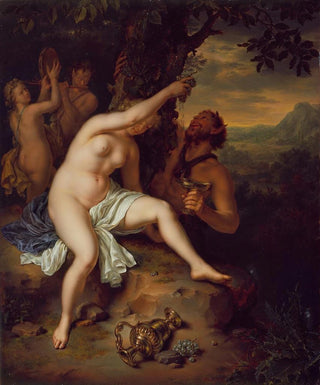Art print | Bacchic scene - Willem van Mieris Source: Reproduction | Scène bachique - Willem van Mieris


View from behind

Frame (optional)
In the vibrant world of baroque art, "Scene of Bacchic revelry" by Willem van Mieris stands out for its elegance and liveliness. This artwork, which evokes the pleasures of life and festivities in honor of Bacchus, the Roman god of wine and celebration, invites the viewer to immerse themselves in a world where exuberance and joy blend with subtle sensuality. The characters, dressed in colorful draperies, seem to dance to the rhythm of an invisible melody, while the surrounding nature, lush and vibrant, frames this scene of merriment. The art print of this iconic piece allows you to relive the festive atmosphere of the 18th century, while offering a window into the cultural and artistic traditions of the time.
Style and uniqueness of the work
Willem van Mieris's style is characterized by an exceptional mastery of detail and a refined color palette. In "Scene of Bacchic revelry," each element is treated with meticulous care that reflects the artist's skill. The faces of the characters, expressive and lively, capture the very essence of Bacchic euphoria. The play of light and shadow, skillfully orchestrated, gives the scene a striking depth, immersing the viewer in an universe that is both intimate and festive. The composition, balanced and harmonious, invites contemplation, with each gaze discovering a new detail, a new interaction between the characters. The richness of textures, whether in the draperies of clothing or natural elements, enhances the impression of realism while maintaining a certain idealization characteristic of baroque art.
The artist and his influence
Willem van Mieris, a Dutch painter of the 17th century, established himself as one of the masters of his time thanks to his unique style and his ability to capture the spirit of his era. Son of Frans van Mieris, also a painter, he inherited an exceptional craftsmanship and a passion for art that led him to explore various themes, ranging from genre scenes to portraits. His work, "Scene of Bacchic revelry," perfectly illustrates his penchant for

Matte finish

View from behind

Frame (optional)
In the vibrant world of baroque art, "Scene of Bacchic revelry" by Willem van Mieris stands out for its elegance and liveliness. This artwork, which evokes the pleasures of life and festivities in honor of Bacchus, the Roman god of wine and celebration, invites the viewer to immerse themselves in a world where exuberance and joy blend with subtle sensuality. The characters, dressed in colorful draperies, seem to dance to the rhythm of an invisible melody, while the surrounding nature, lush and vibrant, frames this scene of merriment. The art print of this iconic piece allows you to relive the festive atmosphere of the 18th century, while offering a window into the cultural and artistic traditions of the time.
Style and uniqueness of the work
Willem van Mieris's style is characterized by an exceptional mastery of detail and a refined color palette. In "Scene of Bacchic revelry," each element is treated with meticulous care that reflects the artist's skill. The faces of the characters, expressive and lively, capture the very essence of Bacchic euphoria. The play of light and shadow, skillfully orchestrated, gives the scene a striking depth, immersing the viewer in an universe that is both intimate and festive. The composition, balanced and harmonious, invites contemplation, with each gaze discovering a new detail, a new interaction between the characters. The richness of textures, whether in the draperies of clothing or natural elements, enhances the impression of realism while maintaining a certain idealization characteristic of baroque art.
The artist and his influence
Willem van Mieris, a Dutch painter of the 17th century, established himself as one of the masters of his time thanks to his unique style and his ability to capture the spirit of his era. Son of Frans van Mieris, also a painter, he inherited an exceptional craftsmanship and a passion for art that led him to explore various themes, ranging from genre scenes to portraits. His work, "Scene of Bacchic revelry," perfectly illustrates his penchant for






